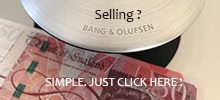Manufacturing - Production Techniques
Manufacturing a Legend - Production Techniques
Several special production techniques are used in Bang & Olufsen appliances. For example, the top covers of the company's BeoLab 6000 and 8000 speakers are polished like a mirror, as the designers wanted absolutely no traces of the manufacturing tools used to produce it. This process is reportedly quite difficult to achieve and requires a special polishing machine that uses diamonds in the cutting process.
In addition, the company's new remote Beo1 (with only 11 buttons - see the 'cabinet' above) and a banana-shaped cordless telephone - BeoCom 2 - are made of 100 % polished aluminium. "We polish the round shapes with a 5-axis robot arm," says Mr. Mortensen of B&O. "We want the naked aluminium because that makes the visual difference. Bare aluminium is very touch-sensitive: if a part has a fingerprint on the surface it cannot be anodised and cannot be used (in that case, it's recycled). And to achieve the colours we want, our designers had to acquire special anodising knowledge."
He continues: "A second example of production technology is the advanced techniques we use for our Beovision Avant televisions. The casing is made of extra strong MDF to be vibration-free for the powerful built-in loudspeakers and to reduce mechanical noise from a built-in VCR. We wanted a very strong paint that would not deteriorate under sunlight. Therefore, we borrowed techniques from the car industry for our painting shop."
The aluminium cabinet for Beo1 after cutting holes for operation buttons - Factory 5
The Bang & Olufsen brand occupies a special place in the annals of Danish industry. It has, in its 75+ years of existence, become a global icon for design and quality in audio and video appliances. In the book 'Bang & Olufsen, From Vision To Legend', this history is accompanied by breathtaking photography, which shows the Bang & Olufsen products in all their glory, as well as the world and culture in which they exist. Who would have thought that the fine line between art and technology could become so blurred?
Distribution and Dealers
One of the reasons the company experienced problems in the 1980s included problems with product distribution. Ordering was so unpredictable that stockpiled up in Denmark at company headquarters and at dealers' shops. This was partly due to the nature of the way the appliance is purchased: customers do not leave a store with a box, but often place customised orders and change their minds frequently during the process. Another problem is the seasonal nature of the consumer electronics market: sales are highest in autumn and winter, with the busiest months in November and December.
Thus, Bang & Olufsen is working towards an important goal concerning its logistics: made-to-order production and delivery within five days of ordering. "Much work goes into our Retail Ordering System (ROS)," says Mr. Mortensen. "It is Internet-based, contains technical information, service manuals and ordering functionality. It allows the dealer to assemble the configuration of an audio or video set, and the order is copied directly into our assembly computer system. Now, our larger dealers are connected, and at the end of 2001, we expect to have every dealer work with this system. At the moment, about 50 percent of our audio/video products are made-to-order."
Supplier Relations
One factor that helps is Bang & Olufsen's close relationship with its aluminium suppliers. As a small manufacturer, Bang & Olufsen must rely on others for key technology, and the main supplier is Philips (Europe's largest television tube manufacturer), which supplies TV tubes, CD/DVD mechanisms and VCR decks. "Philips is an example of what we call a key supplier," says John Bennet-Therkildsen, head of the Operations Division. "We are small, and we have no supplier exclusivity, and we have to follow the trends in technologies. In addition to key suppliers, we have system suppliers, who manufacture complete subsystems for us. For example, our speaker systems have built-in amplifiers, so we have five suppliers."
As its products are electronic, Bang & Olufsen buys a majority of standard electronic components and has experienced some shortages in the electronic components market. "Until now, we haven't experienced severe problems, but we have had to change some production schedules," says Mr. Bennet-Therkildsen.
During final assembly of the high specification BeoLab 1 active speaker (max power 500 W), a blue test box with studio microphones is lowered onto the speaker unit for the product's first acoustic test. Final testing is done in another larger acoustic chamber in Bang & Olufsen's production facility.
Created: 10th January 2007
Modified: 22nd March 2007






